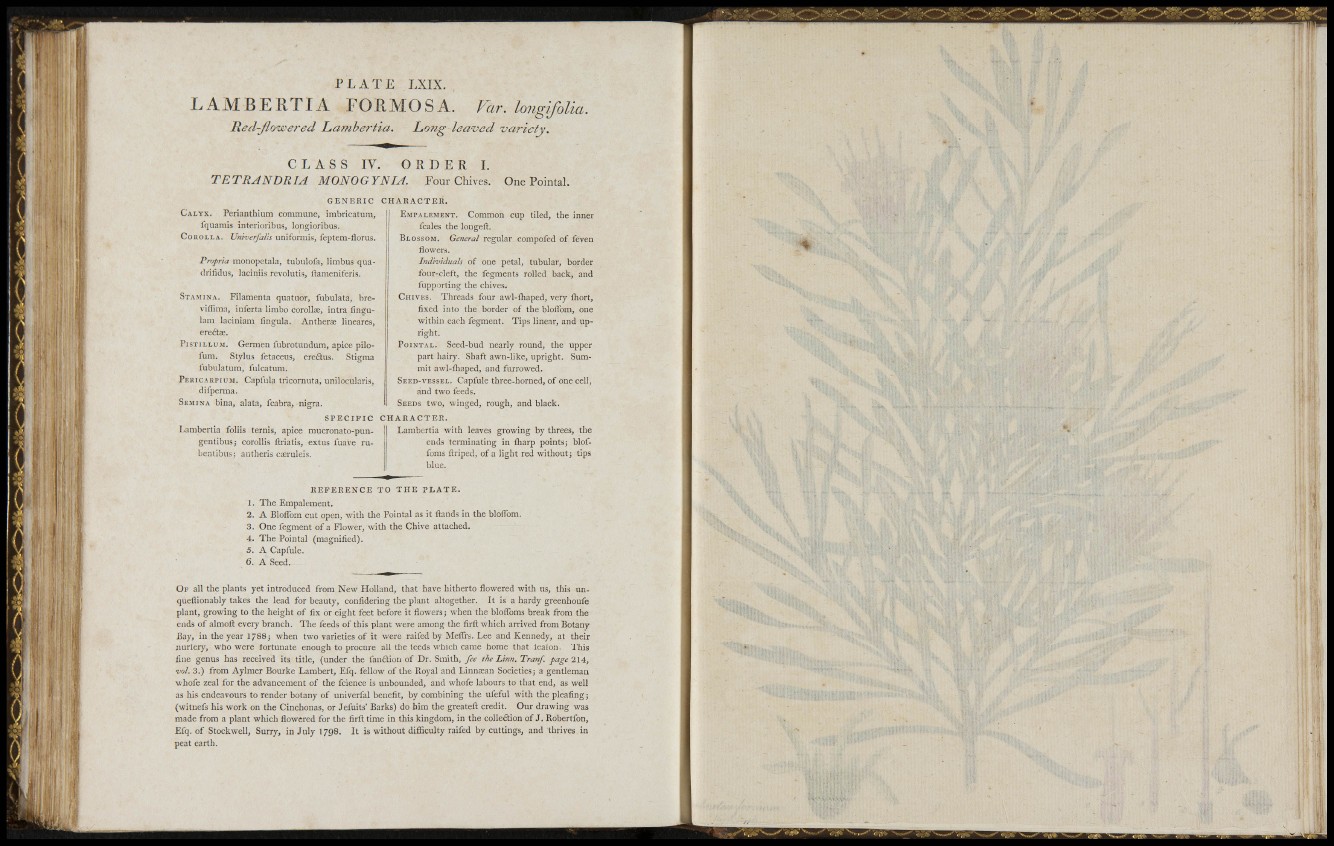
îi;ir'
^ i-
.iîl''
!t
:-t
P L A T E LXIX.
LAMBERTIA FORMOSA, f^ar. longifolia.
Red-flowered Lamhertia. Long-lecwed variety.
C L A S S IV. O R D E R L
TETRANDRIA MONOGYJSIA. Four Chives. One Pointal.
GENERIC
CALYX. Periantliium commune, imbricatum,
fquamis interioribus, longioribus.
C O R O L L A . Unherfalh uniformis, leptem-florus.
Propria monopetala, tubiilofa, limbus quailrifitUis,
laciniis revolutis, llameniferis.
STA!MINA. Filamenta quataor, fubulata, breviffima,
inferta limbo corollae, intra lingu-
1am laciniam lìngula. Antherse lineares,
ereétae.
P I S T I L L U M . Germen fubrotundum, apice pilolum.
Stylus letaceus, ereftus. Stigma
iubiilatum, fulcatum.
P E K I C A K P I U M . Capiula tricornuta, unilocularis,
difperma.
SEMINA bina, alata, fcabra, nigra.
SPECIFIC
I..amberlia foliis ternis, apice mucronato-pungentibus;
corollis llriatis, extus fuave rubentibus;
antheris Cceruleis,
CHAEACTER.
KMPALEMENT. Common cup tiled, the inner
fcales the longeft.
BLOSSOM. General regular compofed of feven
flowers.
Indh'iduals of one petal, tubular, border
four-cleft, the fegments rolled back, and
fupporting the chives.
CHIVES. Threads four awl-fhaped, very fliort,
fixed into the border of the bloifom, one
within each fegment. Tips linear, and upright.
P O I N T A L . Seed-bud nearly round, the upper
part hairy. Shaft awn-like, upright. Summit
awl-fliaped, and furrowed.
SEED-VESSEL. Capfule three-horned, of one cell,
and two feeds.
SEEDS two, winged, rough, and black.
CHARACTER.
Lambertia with leaves growing by threes, the
ends terminating in lharp points; bloffoms
ftriped, of a light red without; tips
blue.
REFERENCE TO THE PLATE.
1. The Empalement.
2. A Bloflbm cut open, with the Pointal as it ftands in the bloffbm.
3. One fegment of a Flower, with the Chive attached.
4. The Pointal (magniiied).
5. A Capfule.
6. A Seed.
OF all the plants yet introduced from New Holland, that have hitherto flowered with us, this unqueflionably
takes the lead for beauty, confidering the plant altogether. It is a hardy greenhoufe
plant, growing to the height of fix or eight feet before it flowers; when the bloffoms break from the
ends of almoft eveiy branch. The feeds of this plant were among the firft which arrived from Botany
Bay, in the year 1788; when two varieties of it were raifed by MelTrs. Lee and Kennedy, at their
jiurfery, who were fortunate enough to procure all tlie feeds which came home that feafon. Tliis
fine genus has received its title, (under the fanftion of Dr. Smith, fee the Linn. Tranf. page 214,
•vol. 3.) from Aylmer Bourke Lambert, Efq. fellow of the Royal and Linnsean Societies; a gentleman
whofe zeal for the advancement of the fcience is unbounded, and whofe labours to that end, as well
as his endeavours to render botany of univerfal benefit, by combining the ufeful with tlie pleafing;
(witnefs his work on the Cinchonas, or Jefuits' Barks) do him the greateft credit. Our drawing was
made from a plant which flowered for the firft time in this kingdom, in the colledlion of J . Robertfon,
Efq. of Stockwell, Surry, in July 1798. It is wi thout difficulty raifed by cuttings, and thrives in
peat earth.
I.,- J